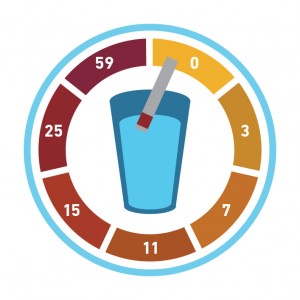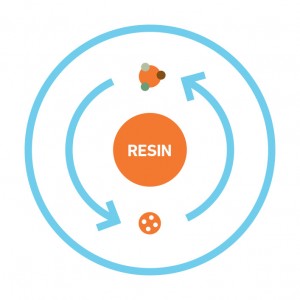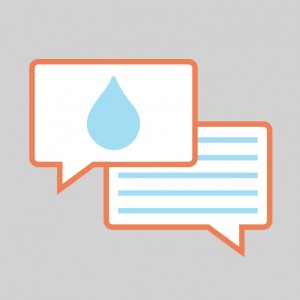Getting to Know Hard Water Terms
If you’re dealing with hard water in your home, it may seem like you’ve entered a whole new world. Between system research and the completely new vocabulary, it’s a lot to take in. To help ease the learning curve and make you a confident and informed shopper, get to know some water softener terminology you may come across in your search to find the perfect softener for your home and why they’re important.
Hard Water 101
Just starting your hard water research? Here is some key water softener terminology you’ll need to know to help put the puzzle pieces into place.
 Hard water: A high concentration of calcium and magnesium make water hard. When water flows through soil and rocks, the materials are mixed with the water. Depending on where you live, your water could be harder than most because your water is traveling through more soil than other areas.
Hard water: A high concentration of calcium and magnesium make water hard. When water flows through soil and rocks, the materials are mixed with the water. Depending on where you live, your water could be harder than most because your water is traveling through more soil than other areas.- Grains per gallon: Grains per gallon — or gpg — is the unit used to measure the hardness of water. This is measured by using one grain (~65 milligrams) of calcium carbonate dissolved in a liter of water. As a reference, let’s look at aspirin. Let’s say there are 10 grains in one aspirin. When it’s dissolved into a gallon of water, it’s reported as 10 grains per gallon. Soft water is considered to have less than 1 gpg. Hard water is anything greater than 7 gpg.
- Parts per million: Measuring water hardness in parts per million (ppm) is rare, but you will occasionally see it when shopping for a new softener. The conversion is 17.1 ppm for every gpg. If iron is found in water, it’s measured in ppm. Iron can leave a reddish brown colored stain on fixtures and appliances when it’s as low as 0.3 ppm. It is very difficult to remove once the stain has been applied, but you can prevent this from happening with a water softener.
- Capacity: Water softeners are measured by either grain capacity, gallons or cubic feet. Before buying a system for your home, you should consider the number of people in your household and how much water you use. Our step-by-step tool will easily guide you toward determining which size is best for your home.
Getting From Hard Water to Soft
Have you ever wondered how adding salt to your tank softens your water? These terms help break down the process.
- Resin tank: The resin tank is where water is softened and incoming hard water passes through ion exchange resin. These resin beads swap the calcium and magnesium in the water for the sodium or potassium they’re holding. This “swapping” of ions softens the water, and it’s the beads in the tank that make it happen.

- Brine tank: This component of a water softener is where you add the salt six to eight times per year. This tank should be filled at least 50 percent of the way to ensure there’s enough salt in the system to soften your water.
- Brine solution: When your system is regenerating, it pulls the salt you add to the brine tank to the water to make a brine solution. This solution “scrubs” the resin beads during regeneration, preparing them to soften more water.
- Regeneration: A water softener removes hard water minerals through a process called regeneration. Resin is recharged after it has exchanged all of its sodium ions for calcium and magnesium from hard water. The same principles are applied for water softeners performing the ion-exchange process for regeneration.
- Timer-based regeneration: These water softeners regenerate on a predetermined schedule that you will set. These outdated models aren’t ideal if you want the most efficient softener. If you underestimate your water usage, the softener will regenerate too infrequently, leaving you with hard water at certain times. Overestimating your water use will result in unnecessary regeneration that wastes energy and water.
- Demand-initiated regeneration: This is the best model if you want an efficient system. Sensors in this system monitor water usage. When the resin is full of hardness minerals, the softener regenerates on its own. This softener works on an as-needed basis, and some advanced models can learn your water use patterns to further optimize regeneration frequency.
System Suggestions
If you’re ready to solve your hard water woes, here are a few styles to consider as you determine the best fix for your home.
- Single-tank water softener: A single-tank system uses an efficient amount of space with its compact design that holds the brine and resin tank in a single cabinet. The “on-demand” feature monitors your water usage in gallons. The softener will regenerate during off periods when capacity is reached. It’s almost impossible to run out of soft water.
- Twin-tank water softener: This model uses more floor space but that’s because of the two resin tanks. The space accommodation is worth it. When one tank is being used for soft water, the other is regenerating soft water in case more is needed throughout the day. The twin-tank system is great for large families who need more soft water during the day, making the higher cost well worth it.
Upgrades and Features to Consider
Looking to go above and beyond a standard softener? These add-ons may be for you.
- Water refiner (hybrid): Remove chlorine and other impurities causing poor taste and foul odor from your water with a whole home filter system that works with your water softener. The filters in this system never have to be replaced as long as the softener lasts.
- Sediment filter: Remove leftover silt and sediment from your water before it enters your softener with a sediment filter. Your softener is vulnerable when it gets too dirty. That’s why this system is proactive in sediment removal. Your appliances and plumbing can also be affected by too much sediment. This filter will keep your system’s water clean.
- Blending val
 ve: Some people prefer slightly harder water because soft water is generally slicker. A blending valve allows for some of the hard water causing minerals to remain in your water. This accessory leaves your water at about 2 gpg, whereas water from a softener is at zero.
ve: Some people prefer slightly harder water because soft water is generally slicker. A blending valve allows for some of the hard water causing minerals to remain in your water. This accessory leaves your water at about 2 gpg, whereas water from a softener is at zero. - Routine maintenance: Although low maintenance, there are a few easy ways you can make water softeners work more efficiently and last longer.
- Salt bridge: This is when a solid crust develops in the brine tank and forms an empty space between your water and scale. This stops the salt from dissolving and making brine. Use a broom handle to carefully push on the top of the salt, using a little bit of pressure to break it up if it has solidified.
- Salt mushing: This is when the dissolved salt in your tank reforms and creates a sludge-like substance at the bottom of the brine tank. Salt mushing creates blockage in the tank, negatively affecting the regeneration process. The only way to fix this is to drain the softener of its water, dig out all the old salt, and replace it with fresh salt.
- Water softener cleanser: By using a water softener cleanser every four months you can maintain your water softener’s peak efficiency and performance. It also helps remove harmful deposits from your water softener’s resin bed, valve and system.
Making Water-Softener Speak Work for You
With a new understanding of the key terms associated with hard water and water softeners, finding the best solution for your home will be a breeze. To help narrow down your search even more, get your personalized softening solution based on your unique needs.

